Back in October, I added a new tray to my Worm Factory 360 to keep all those ravenous red wigglers well fed. And then… I kinda forgot about them for a while. Blame the wedding… which I use as an excuse for every end-of-year procrastination, including my Christmas gifting, my garden digging, my oil changing, even my tax preparing. And, uh… those are still not done.
But I digress. I finally got around to harvesting my worm compost, and luckily, my hub has been feeding our Wormville every week from the compost pail on our counter. (If you don’t own a pail like this for your kitchen, I highly recommend it — it beats running out to the vermicomposter every night to unload your scraps.)
Though I added my second tray in October, my first tray has been steaming and stewing since last August when Nature’s Footprint sent me their Worm Factory 360 to test… six busy months of being broken down by thousands of worms working their way through my garbage. All those onion skins, banana peels, and cantaloupe rinds have magically been transformed into rich, black castings.
Collecting worm compost is a pretty straightforward process. It typically takes around three months for your worms to finish a tray (if you don’t forget about it like I did) and you will likely have a second (or maybe a third) tray in the works by the time your first tray is ready. That means your Worm Factory 360 will continue to be a lean, mean, scrap-munching machine, even as you pull off one of your trays.
Remember that new trays are always added on top, so you’ll want to harvest from your bottom tray. Simply remove the lid and any upper trays, and scoop all the castings into a bucket.
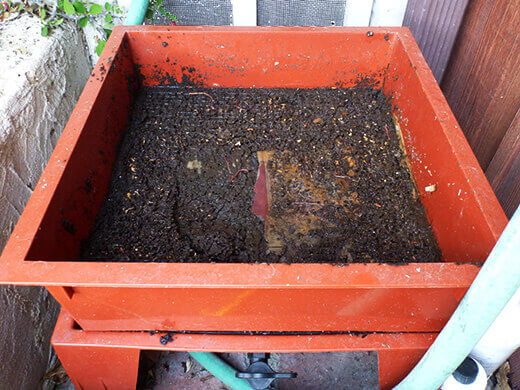
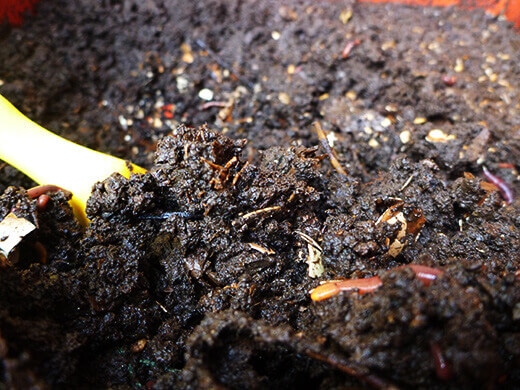
Fully finished compost resembles a fine, crumbly, black peat. You might find newspaper strips or random scraps that haven’t fully composted yet, but that’s fine — they’ll continue to biodegrade. You’ll likely find a few worms along for the ride as well, but they’ll continue to live happy lives in the earth, so no need to move them back into the bin.
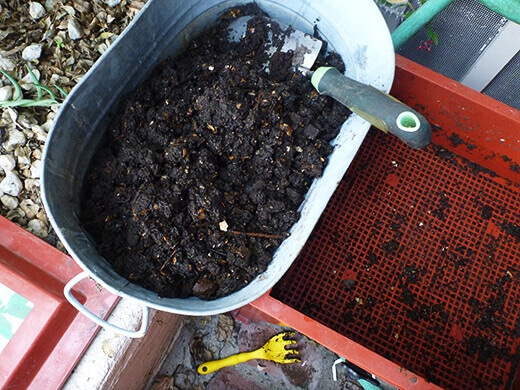
(As my bottom tray had long been finished, I didn’t find too many worms still lingering in it — most of them had already migrated to the top tray. But if you see more than a handful of worms in your bottom tray, you’ll want to encourage them to migrate to the other trays first. To do so, remove all your trays except for the bottom tray and set them aside. Then, remove the bottom tray and stack it on top of the other trays. Replace the whole stack on the base with the lid off. The sudden exposure to light and air will force the worms to move downward where it’s dark and moist. After leaving the lid off for a few hours, you can harvest your compost as above.)
With all the trays removed from the base, check the catch-all tray containing the worm ladder. Collect the castings that have accumulated in that tray (I had a fair amount that fell through from the tray above).
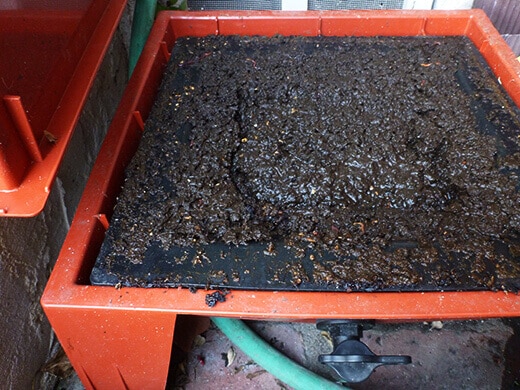
Drain the tray of any leachate by turning the spigot in front. You can save this leachate and dilute it with water to use as fertilizer for your landscaping plants. (As I’d mentioned in my previous post, leachate is not the same as compost tea and its nutritive value is hit or miss. Remember: If it smells bad, don’t use it.)
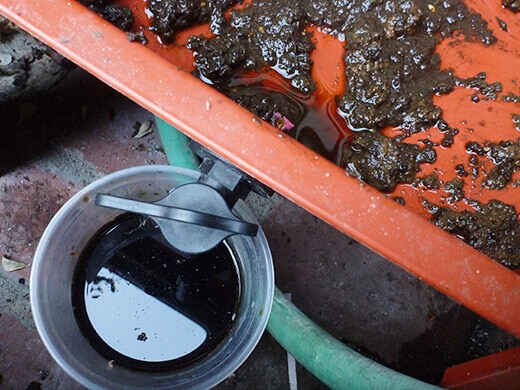
Place your active tray back on the bin. If it’s almost full, you can take your old (empty) tray and stack that on top, using the same method for adding a new tray. Your active tray now becomes the bottom tray for your worms to finish composting, and your top tray becomes the active tray to which you add more food.
Since my active tray was less than half full, I decided to let the worms go to town for another few weeks before I add a new tray. In went a heaping of kitchen scraps and shredded paper, followed by a couple sheets of moistened newspaper, then the lid.
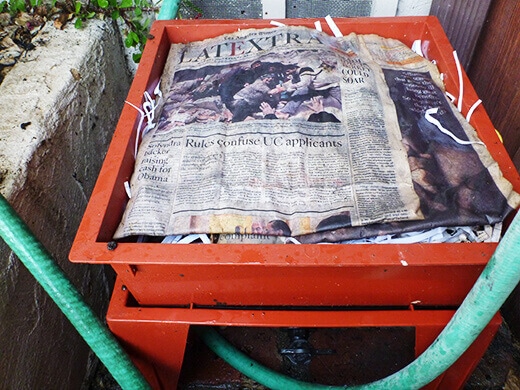
As for all the worm compost I’d just harvested, it can be used right away or it can be stored in a non-airtight container. Just make sure the compost never dries out, as you want to keep a damp, favorable environment for those microbes. In ideal conditions, the compost should keep for up to three years.
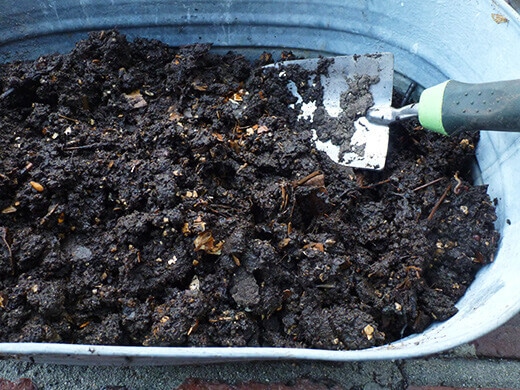
If you want to learn how to set up your vermicomposter, click here for my first post in the series.
This post is brought to you by Nature’s Footprint. Thank you for supporting the sponsors that support Garden Betty.
















Bobbi Thomas liked this on Facebook.
Jun Iguchi liked this on Facebook.
Hi Linda…new subscriber Greg here. (I had much trepidation in subscribing…I could see myself spending WAY too much time reading your posts – you could seriously be my sistah from anotha mutha).
Quick question – Where did you get your worms from? I’ve (sadly) had my vermicomposter sitting on my deck, unused, for more years than I can count. But I’m determined to get this sucker up and running before years end (plenty of time for a serial procrastinator, right?) I was looking at ordering them online from uncle Jims worm farm, but wanted to know if you had a local source that isn’t crazy expensivo.
Once that is done, I can start looking into this backyard chicken business…
I harvested my worms from an existing compost heap (see http://gardenbetty.com/2012/08/vermicomposting-a-way-with-worms/) but you can also find red wigglers on Craigslist for cheap. I recommend starting with a pound (about 1,000) of worms; they multiply very quickly. Have fun!
Excellent idea, Craigslist. Muchas Gracias!
Jun Iguchi liked this on Facebook.
Bobbi Thomas liked this on Facebook.
We’ve been composters for decades in piles out back. About 7 years ago I got excited to try vermicomposting. It was fun, but I began to wonder why I was vermicomposting when I had perfectly good compost heaps going outside. Do you vermicompost instead of having a compost pile outside? Is vermicomposting better for folks with limited space?
Vermicomposting can certainly be easier for folks with limited space as vermicomposting systems can be used inside or on balconies. In addition, vermicompost is richer in concentrated nutrients than traditional backyard composting, though the volume is smaller.
Thanks Kate. I think I’m looking for the impetus to buy some more red wigglers and set up my worm bin again. Spring is right around the corner here in New England and I think I have a case of cabin fever. Vermicomposting is pretty exciting, isn’t it? Kind of having livestock without the noise ;)!
I actually have several compost heaps going on at any given time – my vermicomposter (which is right outside my kitchen door, so it’s mostly for food scraps); a couple piles of compost in the backyard where I toss all my dead plants, tree trimmings, dried leaves, and wood ash; and rotating piles of chicken manure (mixed with pine shavings).
Before I had the vermicomposter, I used to run all my food scraps into the yard to my compost tumbler, but now I only add food to it when I have a large pile of food (like when I juice oranges). For day-to-day small scraps, I find the vermicomposter much more convenient.
Thanks Linda! Oh, one more question. How long do you think one needs to compost chicken bedding before adding to veg garden?
I let my chicken bedding sit for six months before I use it.
Matt Powers liked this on Facebook.